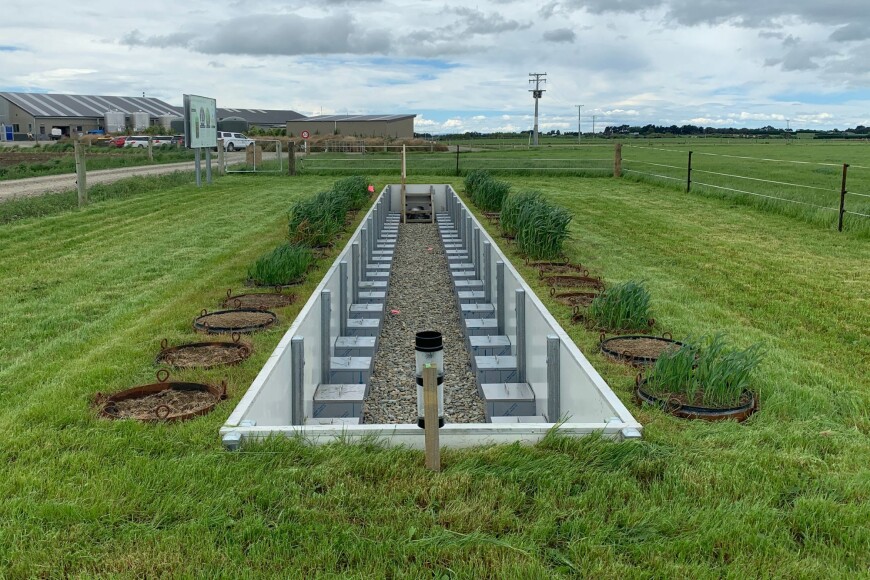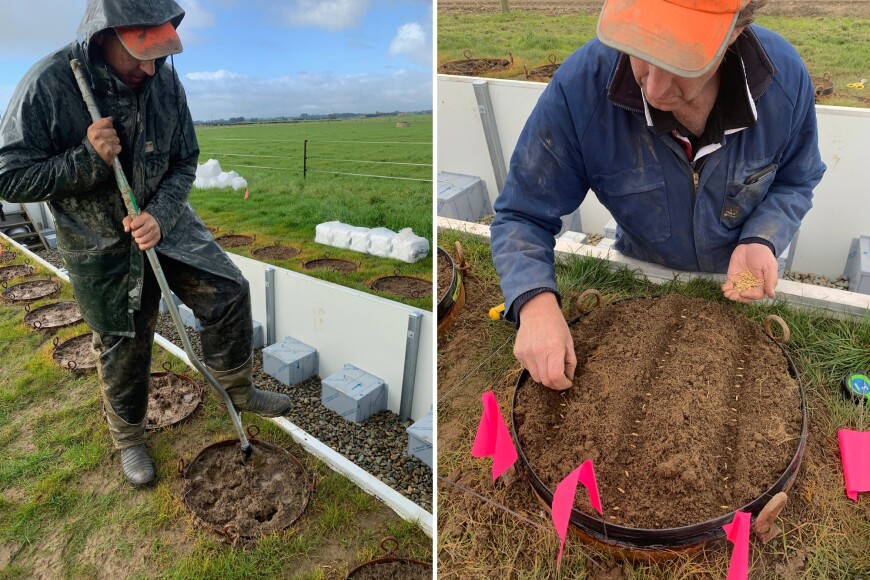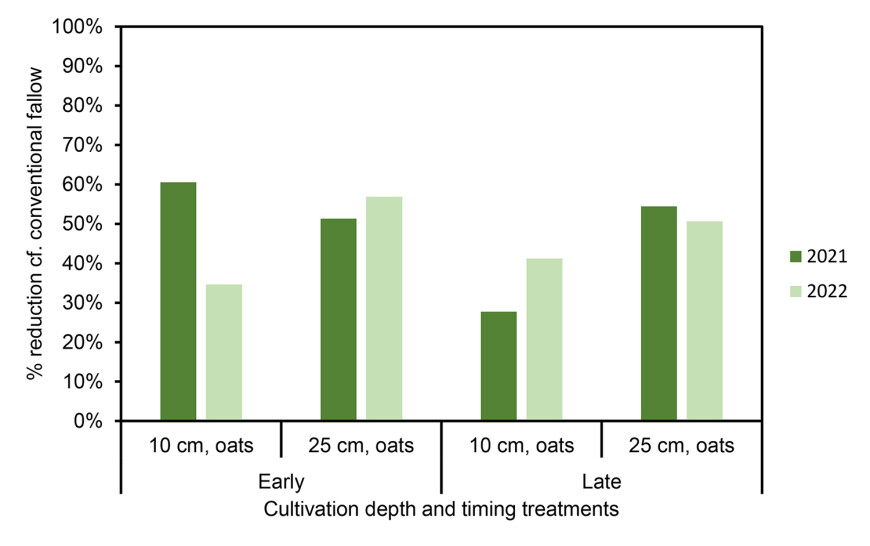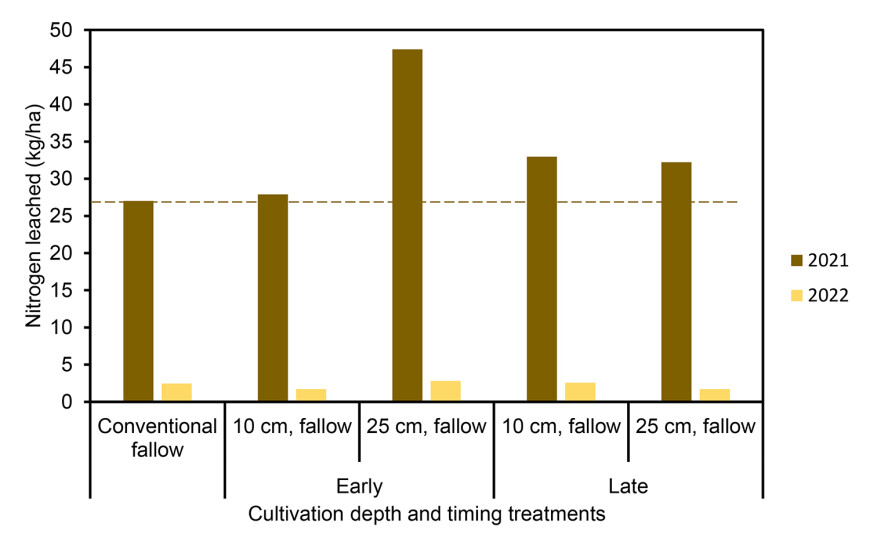Can winter-sown catch crops reduce nitrate leaching in cold environments?
Catch crops are fast-growing, short-term species (e.g. oats, Italian ryegrass) that establish quickly and mop up excess N in winter / early spring, primarily to reduce nitrate leaching. Research in Canterbury has shown that catch crops reduce N leaching from urine patches by up to 50% (Malcolm et al. 2022; Carey et al. 2016), but their effectiveness in colder environments such as Southland had remained untested.
Through a multi-agency collaboration funded by the Ministry for Primary Industries, scientists from the Bioeconomy Science Institute’s Plant and Food Research Group ran repeat field-leaching experiments over 2 years (2021 and 2022) at the Southern Dairy Hub, Southland, using soil monolith lysimeters (50 cm diameter × 70 cm deep) containing intact columns of soil. The Waikiwi soils inside the lysimeters were pugged to simulate grazing, followed by a winter application of fresh cow urine (equivalent to 200 kg N/ha).

Figure 1. A catch crop trial in the soil monolith lysimeter facility at the Southern Dairy Hub, Southland, November 2021.
The cultivation treatments were early cultivated (July/August, winter) at 10 or 25 cm depth, and late cultivated (September/October, spring) at 10 or 25 cm depth, which were compared with a winter fallow control (pugged, no cultivation). Oats were then hand-sown in 50% of all cultivated lysimeter treatments in winter or spring, and drainage water was collected and analysed for mineral-N (ammonium and nitrate) until winter oats reached green-chop silage maturity (November/December).

Figure 2 (left). Manually pugging lysimeters to represent ground conditions after winter forage crop grazing.
Figure 3 (right). Sowing oats into hand-cultivated lysimeters.
Winter-sown oats were shown to reduce mineral-N leaching by 35–61% compared with the fallow control (Figure 4). Delayed sowing until spring achieved similar reductions (28–54%), indicating a potentially larger window of opportunity to establish catch crops in colder climates like Southland’s. Cultivation increased leaching in some non-seeded plots when compared with the fallow control (by up to 76%), probably from enhanced N mineralisation (Figure 5), but oats were shown to mitigate this added risk. Reductions in leaching were attributed to the 62–137 kg/ha of N captured in above-ground biomass of oats, which yielded 2.7–12.8 t DM/ha. Oat yields and N uptakes were on average 6.1 t DM/ha and 35 kg N/ha greater with early sowing than with late sowing. Higher rainfall during the 2021 experimental period (370 mm) compared with 2022 (300 mm) resulted in higher drainage (264 versus 131 mm on average) and N leaching (Figure 5).

Figure 4. Percentage reduction in the amount of mineral nitrogen leached under oat catch-crop treatments (‘oats’) compared with a conventional fallow. Cultivation depths of either 10 cm or 25 cm were imposed shortly after urine application in late July / early August (‘Early’), or 8–9 weeks after urine application (‘Late’). Oats were sown immediately after cultivation.

Figure 5. The amount of nitrogen leached (kg/ha) under conventional and cultivated fallow treatments. Cultivation depths of either 10 cm or 25 cm were imposed shortly after urine application in late July / early August (‘Early’), or 8–9 weeks after urine application (‘Late’).
Collective research into catch crops has shown that winter-active species have a marked ability to establish, even during the coldest months, and to capture significant amounts of N before it is leached. An important mechanism is their ability to take up N over and above requirements during early-growth stages (i.e. luxury N uptake). For instance, approximately 50% of the total N uptake has often been captured by the plants when only 10–20% of the biomass has accumulated.
The most important piece of advice for farmers is to sow winter-active species (e.g. cereal such as oats and/or short-rotation ryegrass) as early as possible after winter grazing, when daily average soil temperatures are 4°C or above.
References
- Carey PL, Cameron KC, Di HJ, Edwards GR, Chapman DF 2016. Sowing a winter catch crop can reduce nitrate leaching losses from winter-applied urine under simulated forage grazing: a lysimeter study. Soil Use and Management 32(3): 329–337. Link
- Malcolm B, Cameron K, Beare M, Carrick S, Payne J, Maley S, Di H, Richards K, Dalley D, de Ruiter J 2022. Oat catch crop efficacy on nitrogen leaching varies after forage crop grazing. Nutrient Cycling in Agroecosystems 122(3): 273–288. Link
Acknowledgements
Primary funding was provided by the Ministry for Primary Industries’ Sustainable Land Management and Climate Change – Freshwater Mitigation (SLMACC-FM) programme, with financial support from Environment Canterbury and Environment Southland, and in-kind support from DairyNZ, Beef + Lamb NZ, the Foundation for Arable Research, Environment Canterbury, Environment Southland, and Overseer Limited. The Southern Dairy Hub supported and hosted the trial work. The Bioeconomy Science Institute (Plant & Food Research Group) and DairyNZ provided valuable technical assistance with daily management and data collection.
Key contact
Brendon Malcolm
Senior Scientist, Team Leader (Soil Function & Health), Acting Science Group Leader (Cropping Systems & Environment)
Bioeconomy Science Institute, Plant and Food Research Group
